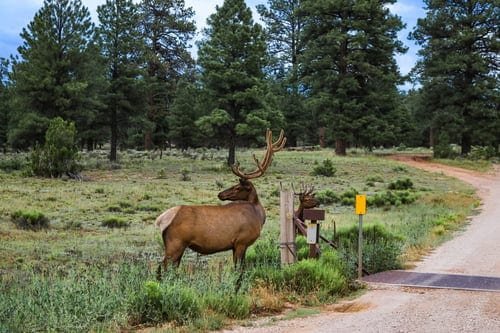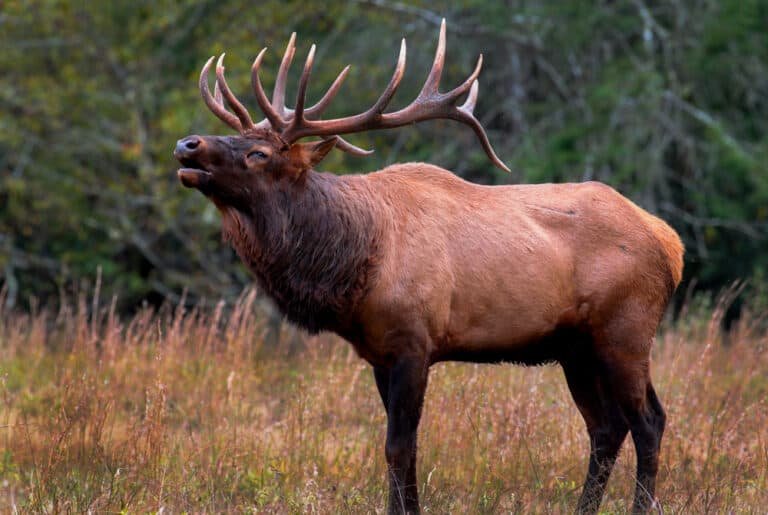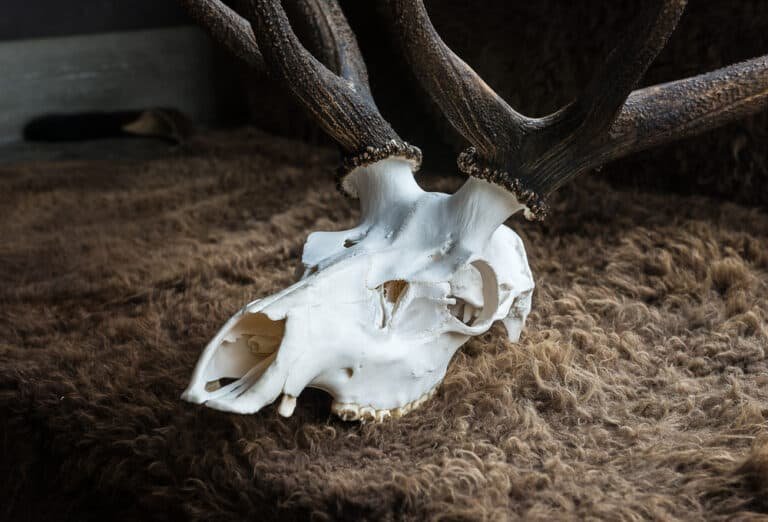Best Elk Hunting Rifles – A Shot in the Dark!
Ever dreamt of bagging a magnificent bull elk and experiencing the rugged thrill of the hunt? You need to review best elk hunting rifles available.

Elk hunting, a pinnacle achievement for many hunters, demands the perfect combination of skill, strategy, and equipment. In this blog, we’ll delve into the world of elk hunting rifles, exploring the top contenders and their strengths and weaknesses to help you choose the ideal firearm for your next adventure.
A Dance Between Man and Nature
Elk hunting is not merely a recreational activity but an exhilarating dance between man and nature. With their robust physiques and elusive behavior, these magnificent creatures demand respect from those who seek them.
The pursuit of elk requires skillful stalking through dense forests, traversing treacherous terrain, and maintaining unwavering focus amidst the adrenaline rush of close encounters. The allure lies not only in the excitement of the hunt itself but also in the reverence for these regal animals.
Elk embody strength, resilience, and grace—embodying untamed wilderness. For many hunters, pursuing elk is about immersing themselves in nature’s grandeur while testing their abilities against one of North America’s most formidable game animals.
The Crucial Role of Rifle Selection

One cannot overstate the importance of selecting an appropriate rifle for elk hunting. A well-chosen firearm becomes an extension of the hunter’s capabilities—a tool that must strike a harmonious balance between power, precision, and suitability for varied terrain.
The right rifle can make all the difference between a successful harvest or a missed opportunity. Ensuring ethical kills is paramount when engaging in any form of hunting.
Elk are large-bodied animals with thick hides that demand sufficient firepower to deliver effective shots without causing undue suffering or wasted meat. By choosing a rifle specifically designed for elk hunting purposes—optimizing factors such as caliber selection, action type, and optics—hunters can significantly enhance their chances of success while maintaining ethical standards.
The Marriage of Skill and Equipment
Elk hunting is a testament to the harmony between human skill and purpose-built equipment. The selection of an ideal rifle for elk hunting requires careful consideration of various factors, including caliber choice, action type, optics, and stock design. Each component plays a vital role in ensuring accurate and humane shots under challenging circumstances.
As we delve deeper into the realm of elk hunting rifles, it becomes evident that this pursuit demands not only skillful marksmanship but also a deep understanding of ballistics, firearm mechanics, and the terrain in which these majestic animals reside.
By equipping themselves with knowledge and making informed choices when selecting their tools, hunters can embark on their elk hunting adventures with confidence—a testament to their commitment to both responsible hunting practices and an enduring connection with nature’s wilderness.
Caliber Selection
Popular calibers for elk hunting
When it comes to elk hunting, selecting the right caliber is crucial. Two popular choices among hunters are the venerable .30-06 Springfield and the powerful .300 Winchester Magnum.
The .30-06 has a long-standing reputation for its versatility, capable of delivering ample energy and accuracy at varying distances. It offers a wide selection of available ammunition, making it accessible and affordable for many hunters.
On the other hand, the .300 Winchester Magnum provides even greater firepower with its larger case capacity and higher muzzle velocity. This gives shooters extended range capabilities and excellent performance when dealing with tough game like elk.
Ballistic performance and energy transfer
In elk hunting, one must consider the ballistic performance of a rifle cartridge to ensure effective shot placement. A well-chosen caliber should deliver sufficient energy upon impact to ethically take down an elk without causing unnecessary suffering.
Key factors to evaluate include bullet weight, velocity, sectional density, and terminal ballistics. Optimal cartridges will retain their momentum throughout their trajectory while offering controlled expansion upon impact for reliable penetration through an elk’s thick hide.
Recoil management and shooter comfort
When wielding a high-powered rifle against formidable game like elk, recoil management is paramount for shooter comfort and accuracy. A rifle that produces excessive recoil can affect follow-up shots by inducing flinching or developing bad shooting habits.
It is crucial to strike a balance between adequate stopping power and manageable recoil when selecting an elk hunting rifle. Recoil pads or devices designed to reduce felt recoil can significantly enhance shooter comfort during extended hunts or when taking multiple shots in quick succession.
Action Types
Bolt-action rifles: Reliability & Accuracy
Bolt-action rifles have long been favored by hunters for their inherent reliability and exceptional accuracy. Their robust design, with a manually operated bolt mechanism, provides consistent and precise chambering of rounds.
This reliability is crucial in demanding elk hunting scenarios where dependability is essential for a successful hunt. Bolt-action rifles often exhibit excellent inherent accuracy due to their rigid construction and consistent lock-up, making them ideal for hunters who prioritize precision.
Considerations for long-range shots and follow-up shots
For hunters planning to take longer shots on elk or requiring quick follow-up shots, bolt-action rifles offer advantages worth considering. Their inherent accuracy allows skilled shooters to engage targets at extended ranges reliably.
Additionally, the ability to swiftly cycle the bolt enables faster follow-up shots compared to other action types. However, it’s important to note that effective long-range shooting requires extensive practice, familiarity with ballistics, and consideration of external factors such as wind drift.
Lever-action rifles: A Touch of Tradition
Lever-action rifles hold a unique place in American hunting culture due to their historical significance and undeniable charm. Although not as common in modern elk hunting as other action types, lever-actions can still be effective tools depending on the hunt parameters.
They excel in close-range encounters where fast target acquisition is necessary since lever-actions typically have shorter barrel lengths than bolt-actions. Their rapid repeat-fire capability can be advantageous when dealing with fast-moving game or situations that require quick follow-up shots.
Semi-automatic rifles: Rapid Follow-Up Shots & Drawbacks
Semi-automatic rifles offer several advantages for elk hunting enthusiasts seeking rapid-fire capabilities and reduced recoil compared to other action types. The ability to fire multiple shots without manually cycling the action allows for quicker follow-ups if needed during high-pressure situations or when engaging multiple targets consecutively.
Additionally, semi-autos can help mitigate recoil-induced shooter fatigue, which can be beneficial during long hunts. However, it is important to acknowledge that semi-automatic rifles can be heavier than other options, potentially affecting maneuverability in challenging terrain.
Furthermore, some hunters express concerns about potential reliability issues in adverse conditions, emphasizing the need for thorough research and reliable firearm choices. Remember, choosing the right elk hunting rifle involves a careful evaluation of factors such as caliber selection, ballistic performance, recoil management, and action type.
Each hunter’s preferences and hunting conditions may vary. Therefore, it is crucial to consider personal comfort and proficiency with different rifles before making a final decision.
Riflescope Selection for Elk Hunting Rifles
Magnification Range Considerations Based on Terrain and Shooting Distances
When it comes to choosing the right riflescope for elk hunting, considering the magnification range is crucial. The terrain in which elk hunting typically takes place can vary greatly, ranging from dense forests to wide-open prairies. As such, selecting a riflescope with an appropriate magnification range is essential.
For close-range encounters in thickly wooded areas, a lower magnification range of 1-4x or 2-7x can provide a wide field of view and quick target acquisition. This allows hunters to react swiftly when elk appear unexpectedly at closer distances.
On the other hand, when hunting in more open terrain or when taking longer-range shots, a higher magnification range of 4-12x or even 6-24x may be preferred. This enables hunters to zoom in on distant targets and make precise shots with confidence.
Reticle Options (e.g., Duplex, BDC, MOA)
The reticle selection plays a significant role in aiding accurate shot placement during elk hunting. Different reticles offer unique advantages based on personal preference and shooting style. The duplex reticle is one of the most popular choices due to its simplicity and versatility.
It features thick outer lines that taper to thinner crosshairs at the center. This design allows for quick target acquisition while still providing precise aiming points for longer shots.
For those who prefer long-range shooting or want to compensate for bullet drop at extended distances, Bullet Drop Compensator (BDC) reticles are highly beneficial. These reticles have additional aiming points below the center crosshair, calibrated to specific distances or ballistic trajectories commonly encountered while hunting elk.
Minute of Angle (MOA) reticles offer precise holdover points based on angular measurements. These reticles often come with hash marks or dots that allow hunters to compensate for windage and bullet drop with ease.
Optimal Objective Lens Size for Low-Light Conditions
Elk hunting often involves early mornings and late evenings when light conditions are less than ideal. Choosing a riflescope with an optimal objective lens size is crucial for maximizing light transmission and enhancing visibility during these low-light situations.
Objective lens size refers to the diameter of the front lens of the riflescope. Larger objective lenses, typically ranging from 40mm to 56mm, allow more light to enter the scope, resulting in brighter images.
This increased light transmission can make a significant difference in spotting elusive elk in dim lighting conditions. However, it’s important to strike a balance between light gathering capability and overall scope weight.
Larger objective lenses tend to be heavier, which can affect the maneuverability of your rifle. Therefore, selecting an objective lens size around 40-50mm is usually considered optimal for achieving good low-light performance without compromising on weight and handling.
Durability Features (e.g., Waterproofing, Shock Resistance)
Elk hunting can be demanding and unpredictable, subjecting equipment to harsh weather conditions and rough handling. Ensuring your chosen riflescope is equipped with durability features is essential in maintaining its functionality even under adverse circumstances.
Waterproofing is a vital feature since rain or snow showers are not uncommon during elk hunting season. Look for scopes with proper sealing or O-ring seals that prevent water from entering the internals of the scope.
Shock resistance is another crucial consideration as riflescopes may experience recoil forces when firing powerful cartridges used for elk hunting. Opt for scopes built with sturdy construction materials like aircraft-grade aluminum or reinforced polymers that can withstand such impacts without losing zero or internal alignment.
Additionally, features like fog-proofing through nitrogen purging eliminate internal fogging caused by temperature changes, ensuring clear optics in all weather conditions. Investing in a riflescope with these durability features will not only protect your investment but also ensure optimal performance when you encounter challenging situations while hunting elk.
By paying attention to magnification range, reticle options, objective lens size, and durability features, you can select a riflescope that perfectly complements your elk hunting needs and improves your chances of success in the field. Remember that the choice of a riflescope should align with your shooting preferences, environmental factors, and personal comfort level to enhance your overall hunting experience.
Stock Design and Ergonomics for Elk Hunting Rifles
Traditional Wood Stocks vs Synthetic Stocks
When it comes to choosing the right stock for your elk hunting rifle, you’ll often encounter a choice between traditional wood stocks and modern synthetic stocks. Synthetic stocks have gained popularity among hunters due to their numerous advantages, particularly in harsh weather conditions. These stocks are typically made from materials like fiberglass or carbon fiber, which offer exceptional durability and resistance to moisture.
When venturing into the wilderness during inclement weather, a synthetic stock ensures that your rifle remains unaffected by rain, snow, or humidity. This factor alone can significantly enhance the longevity and reliability of your firearm.
While synthetic stocks excel in practicality and resilience, there is an undeniable classic appeal associated with traditional wood stocks. Wood has been used for centuries in crafting firearms and evokes a sense of nostalgia for many hunters.
Beyond aesthetics, wood stocks offer natural insulation against temperature extremes and absorb recoil more effectively than their synthetic counterparts. The warm feel and grain patterns of wood also provide a unique tactile experience that many hunters find pleasing.
Sling Attachments and Swivels
Using slings while hunting provides several benefits that can greatly improve your overall experience in the field. First and foremost, slings help distribute the weight of your rifle across your body, reducing fatigue during long treks through rugged terrain.
This added comfort allows you to maintain focus on the hunt rather than being distracted by physical discomfort. Furthermore, slings enable quick accessibility to your weapon without impeding movement when traversing challenging landscapes or navigating dense vegetation.
They provide stability during off-hand shooting positions or when taking aim from unconventional angles. There are various types of sling attachments available today catering to differing preferences and hunting styles.
Some popular options include detachable swivels that allow for easy removal or attachment of the sling; push-button quick-detach (QD) swivels for rapid sling adjustments; and single-point slings that provide maximum maneuverability in tight spaces. Each option provides its own advantages, so it is essential to find the sling attachment that best suits your individual needs and preferences.
Conclusion
Choosing the right stock design and sling attachments for your elk hunting rifle can significantly impact your hunting experience. Synthetic stocks offer unparalleled durability and resistance to harsh weather conditions, ensuring optimal performance in any environment.
On the other hand, traditional wood stocks provide a classic appeal, natural insulation against temperature extremes, and a unique tactile experience. When it comes to sling attachments, using a proper sling can greatly enhance comfort during long treks while providing stability and quick access to your firearm.
Whether you opt for detachable swivels, push-button QD swivels, or single-point slings will depend on your specific needs and hunting style. By considering these factors carefully and selecting the stock design and sling attachments that suit you best, you’ll be equipped with a rifle optimized for elk hunting success.
So venture forth into the wild with confidence, knowing that you have chosen the perfect combination of stock design and sling attachment for an exceptional hunting experience. Happy hunting!







medication from mexico pharmacy: cmqpharma.com – pharmacies in mexico that ship to usa
purple pharmacy mexico price list
http://cmqpharma.com/# mexican pharmaceuticals online
purple pharmacy mexico price list
I like this site it’s a master piece! Glad I
found this ohttps://69v.topn google.Blog monry
canadian pharmacy uk delivery: canadian pharmacy meds – buy prescription drugs from canada cheap
indian pharmacy paypal indian pharmacy online Online medicine order
https://foruspharma.com/# medicine in mexico pharmacies
top 10 online pharmacy in india: reputable indian online pharmacy – п»їlegitimate online pharmacies india
best online pharmacies in mexico: mexico drug stores pharmacies – purple pharmacy mexico price list
cheapest online pharmacy india: Online medicine order – top online pharmacy india
reputable mexican pharmacies online: mexico drug stores pharmacies – purple pharmacy mexico price list
http://indiapharmast.com/# india pharmacy mail order
trusted canadian pharmacy: cheapest pharmacy canada – canadian drug pharmacy
mexican online pharmacies prescription drugs buying prescription drugs in mexico mexican pharmaceuticals online
legit canadian online pharmacy: safe canadian pharmacy – canadian pharmacy online
india pharmacy: online pharmacy india – indian pharmacy
http://indiapharmast.com/# top 10 pharmacies in india
canada drugs online review: online pharmacy canada – canadian pharmacy phone number
Online medicine home delivery: online shopping pharmacy india – reputable indian pharmacies
indianpharmacy com: india pharmacy mail order – reputable indian pharmacies
http://doxycyclinedelivery.pro/# doxycycline otc drug
http://amoxildelivery.pro/# amoxicillin buy online canada
https://doxycyclinedelivery.pro/# doxycycline 100mg price
https://doxycyclinedelivery.pro/# doxyciclin
https://ciprodelivery.pro/# ciprofloxacin mail online
https://paxloviddelivery.pro/# paxlovid pharmacy
https://paxloviddelivery.pro/# buy paxlovid online
http://doxycyclinedelivery.pro/# doxycycline antimalarial
https://ciprodelivery.pro/# ciprofloxacin 500 mg tablet price